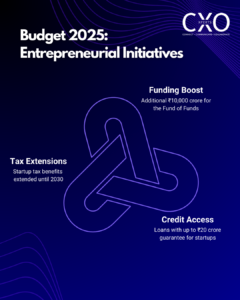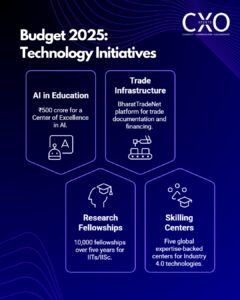The Union Budget 2025-26 sets tone for India’s next phase of economic transformation by focusing on startups, advanced technologies, and green innovation. Presenting the budget, Finance Minister Nirmala Sitharaman emphasized how technology and sustainability will drive India’s journey towards becoming a “Viksit Bharat” by 2047. This year’s budget is designed to strengthen the pillars of innovation, climate-friendly manufacturing, and upskilling, while also addressing the needs of the growing entrepreneurial ecosystem.
Startup Ecosystem Gets a Major Boost

The budget provides a significant financial lifeline to startups through a ₹10,000 crore infusion into the existing Fund of Funds for startups. This investment builds upon the ₹91,000 crore already committed under the initiative, designed to attract venture capital for sectors such as AI, blockchain, and robotics. The government has also extended the deadline for startup incorporation to 2030 to qualify for tax exemptions, offering long-term stability for entrepreneurs.
Access to credit has also been enhanced with a credit guarantee program that allows startups to secure loans up to ₹20 crore. The initiative focuses on 27 key sectors under the Atmanirbhar Bharat framework, aiming to ease working capital challenges while reducing guarantee fees. By fostering greater access to both funding and incentives, the government seeks to empower startups to scale operations both domestically and globally.
Technology Initiatives to Accelerate Digital Growth

The government has unveiled several major initiatives in the Budget 2025 to promote technological growth and workforce development. A new ₹500 crore Center of Excellence for AI in education will be established, building on previous investments in AI research hubs for agriculture, healthcare, and smart cities. The government recognizes the need to prepare India’s workforce for Industry 4.0 and is setting up five National Centres of Excellence for Skilling through global collaborations. These institutions will develop industry-aligned curricula, provide advanced certifications, and train specialists in emerging fields such as data science, automation, and machine learning.
In addition, the PM Research Fellowship program is being expanded to fund 10,000 new fellowships across premier institutes like IITs and IISc over the next five years. This initiative aims to boost India’s research output, focusing on high-impact innovation and technological advancements.
Meanwhile, BharatTradeNet, a digital infrastructure initiative, will streamline international trade processes by digitizing documentation and improving financing options for exporters.
Green Tech Revolution Under the Clean Tech Manufacturing Mission

Climate sustainability remains a cornerstone of the budget’s development agenda. The Clean Tech Manufacturing Mission targets the domestic production of renewable energy components and electric vehicle (EV) batteries. Duties on inputs for lithium-ion battery production have been reduced to zero, making it easier and more cost-effective for manufacturers to scale operations. Additionally, 35 key capital goods for EV battery production have been added to the duty-free import list.
Union Minister Nitin Gadkari, after the release of the budget, also highlighted the significance of the reduction of the duties on the batteries in a post on X.
#WATCH | On #UnionBudget2025, Union Minister Nitin Gadkari says, “Finance Minister Nirmala Sitharaman has presented a historic budget of the country. This budget has a speciality to accelerate our budget. Just like always, this time also, she has given the infrastructure sector… pic.twitter.com/hfIVvxuTsH
— ANI (@ANI) February 1, 2025
Solar and wind energy infrastructure will also benefit from duty exemptions on essential raw materials. This move is expected to attract investment in domestic clean energy production, reducing India’s dependence on costly imports. These policies align with India’s climate goals under the Paris Agreement, ensuring the country can meet its renewable energy targets.
Modernizing Infrastructure with Geospatial Innovation
The budget introduces a National Geospatial Mission aimed at modernizing land records, urban planning, and infrastructure design. By investing in advanced geospatial data collection and analysis, the government seeks to promote sustainable development across key urban and rural areas. This initiative complements ongoing projects in smart city planning, transportation, and resource management.
The push for sustainability extends to electric mobility as well. Duty-free imports of EV-related materials are expected to cut the cost of production and accelerate the adoption of clean transportation solutions. Analysts estimate that these measures could reduce the cost of EV batteries and components by up to 15% over the next two years, making electric vehicles more accessible to consumers and businesses alike.
What are the Challenges and Opportunities Ahead?
While the budget’s focus on technology, startups, and green innovation has been largely praised, some industry leaders have expressed concerns over the timeline for implementing these initiatives. There are also calls for greater coordination among government agencies to ensure that funds and programs reach targeted sectors efficiently.
However, experts agree that the measures outlined in the budget strike a balance between short-term recovery and long-term growth. By investing in innovation-driven industries, digital infrastructure, and climate resilience, the government is laying the groundwork for sustained economic transformation. These efforts are expected to create new opportunities for R&D investment, drive job creation, and strengthen India’s position in global markets.
In an interaction with CXO XPERTS, Ms. Anindita Chatterjee, a partner at TCN Global, stated, “The Union Budget 2025-26 prioritizes tax simplification, economic growth, and taxpayer convenience. A new income-tax bill, set to be introduced soon, aims to reduce provisions by half, ensuring clarity and minimizing litigation. While major reforms were deferred, key updates include revised tax slabs, streamlined withholding tax rates, and enhanced incentives for IFSC investments.”
“Procedural relaxations, such as removing higher tax deductions for non-filers, further ease compliance. Indirect tax changes focus on tariff rationalization, supporting domestic manufacturing, and promoting exports. Overall, the budget reinforces a “trust first, scrutinize later” approach, fostering transparency and efficiency in tax administration.” Ms. Anindita added.
India’s Vision for the Future
The Union Budget 2025 responds to current economic challenges and also anticipates the needs of a rapidly evolving global economy. By fostering apt ecosystems, promoting technological innovation, and investing in clean energy solutions, the government is setting the stage for long-term economic stability. As these policies take effect, India is poised to lead in both technological advancement and sustainable development, securing its place as a global powerhouse for years to come.


